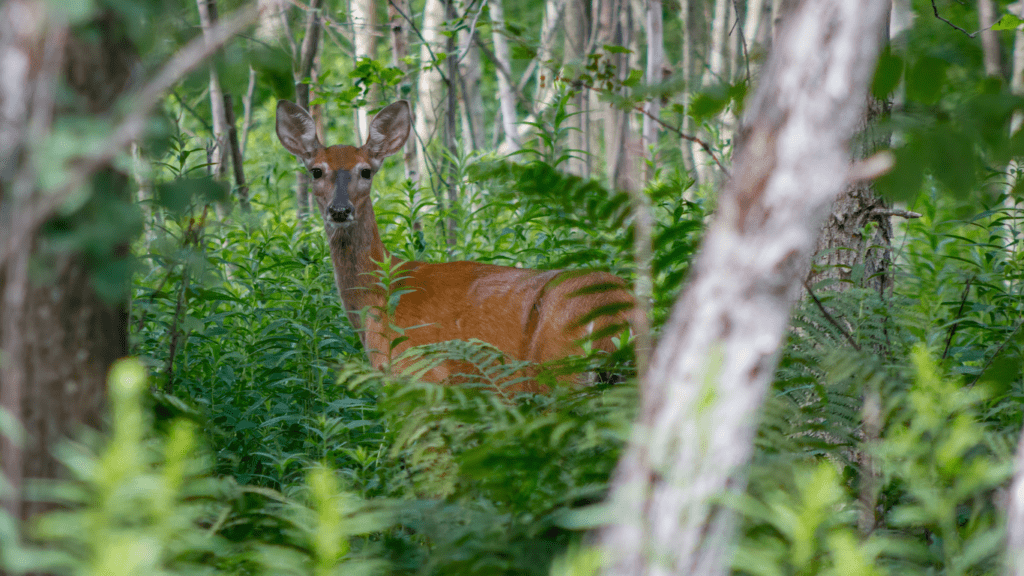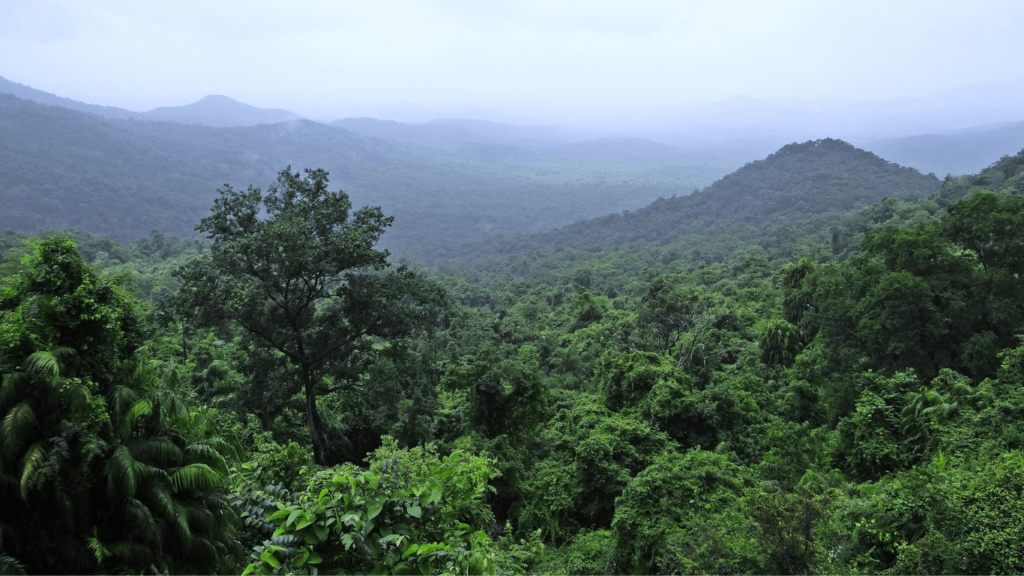Overview Of Forest Wildlife Habitats
Forest wildlife habitats are crucial for the survival and well-being of numerous species. Tropical rainforests support over 50% of the world’s species, while boreal forests house mammals like wolves, lynx, and bears. The specific flora and fauna in these habitats vary greatly depending on geographical location, climate, and forest type. These diverse ecosystems maintain ecological balance and provide resources like food, shelter, and breeding grounds for wildlife.
The complexity of forest habitats depends on factors like:
- tree density
- canopy cover
- understory vegetation
In tropical rainforests, multiple layers exist, including the emergent layer, canopy, understory, and forest floor. Each layer supports different species, which thrive on the unique conditions in each stratum. For instance, the canopy provides shelter for birds and monkeys, while amphibians and insects inhabit the understory.
Coniferous forests, primarily found in northern regions, feature dense clusters of pine, spruce, and fir trees. These forests, characterized by long, cold winters and short summers, shelter species adapted to harsh conditions. The thick canopy protects wildlife from extreme weather, while fallen leaves and branches enrich the soil, supporting diverse plant life.
Temperate forests, located in regions with moderate climates, have a mix of deciduous and evergreen trees. These forests undergo seasonal changes, influencing the behavior and life cycles of resident species. For example, many animals hibernate or migrate during winter, while spring and summer see increased activity and breeding.
The rich biodiversity in these habitats faces significant threats, yet they continue to play a vital role in maintaining global ecological health.
Major Threats To Forest Wildlife Habitats
Forest wildlife habitats face various threats that compromise their sustainability and biodiversity.
Deforestation And Land Use Changes
Large-scale deforestation significantly reduces forest cover. According to the Food and Agriculture Organization (FAO), from 2015 to 2020, the world lost about 10 million hectares of forests annually. Land conversion for agriculture and urban development disrupts ecosystems, displacing species that rely on forest habitats for survival. For instance, the clearing of tropical rainforests for palm oil plantations endangers orangutans by destroying their natural habitat.
Climate Change Impacts
Climate change exacerbates the stress on forest ecosystems. Rising temperatures alter precipitation patterns, leading to extended droughts and increased wildfire frequency. The Intergovernmental Panel on Climate Change (IPCC) states that climate change significantly affects boreal forests, threatening species like the Siberian tiger that depend on stable, cold environments. Altered seasonal cycles also affect temperate forest species, disrupting migration and breeding patterns.
Pollution And Contamination
Pollution from industrial activities and agricultural runoff introduces toxins into forest ecosystems. Heavy metals, pesticides, and plastic waste contaminate soil and water sources. The World Health Organization (WHO) highlights that mercury pollution affects forest mammals and birds, leading to bioaccumulation and health issues. Acid rain, resulting from air pollution, damages trees and alters the pH balance of forest streams, negatively impacting amphibians and fish.
Invasive Species
Invasive species outcompete native species, altering forest ecosystems. Non-native plants, animals, and pathogens spread rapidly due to human activities. For example, the emerald ash borer, an invasive beetle species, has devastated ash tree populations across North American forests. The Center for Invasive Species and Ecosystem Health notes that invasive species cause significant ecological and economic damage, disrupting food chains and habitat structures.
Human-Wildlife Conflicts
Human encroachment into forest areas increases encounters between humans and wildlife, leading to conflicts. These conflicts often result in the harm or death of both humans and animals. The Wildlife Conservation Society (WCS) reports that large mammals like elephants and tigers suffer from habitat fragmentation, which forces them into human settlements in search of food. This leads to retaliatory killings and further endangerment of wildlife species.
These major threats underscore the need for comprehensive protection efforts to preserve and restore forest wildlife habitats.
Current Protection Efforts

Protecting forest wildlife habitats requires coordinated efforts across legal frameworks, conservation programs, community engagement, and technological innovations.
Legal And Policy Frameworks
Governments worldwide have enacted laws to protect forests and their wildlife. The Endangered Species Act (ESA) in the US, for instance, provides legal protection to species at risk of extinction. CITES (Convention on International Trade in Endangered Species) regulates the international trade of flora and fauna to prevent exploitation. National policies, like Brazil’s Forest Code, mandate the preservation of a certain percentage of forests on private properties. These frameworks create a legal basis for conservation and enforce penalties for non-compliance.
Protected Areas And Conservation Programs
Protected areas play a crucial role in conserving forest habitats. National parks, wildlife reserves, and sanctuaries offer safe havens for endangered species. For example, the Amazon Rainforest’s protected areas cover approximately 2 million square miles, safeguarding diverse species. Conservation organizations like the World Wildlife Fund (WWF) and The Nature Conservancy implement programs that focus on habitat restoration, anti-poaching patrols, and reforestation efforts. These initiatives aim to restore ecological balance and ensure the viability of species populations.
Community Involvement And Education
Engaging local communities boosts conservation success. Community-based forest management (CBFM) empowers locals to manage resources sustainably. Education initiatives inform residents about the value of forests and promote conservation practices. In Nepal, for example, community forestry programs have led to increased forest cover and biodiversity. Ecotourism projects generate income while fostering environmental stewardship among community members. By involving people living near forests, these efforts create a collective responsibility for habitat protection.
Technological Innovations In Conservation
Advances in technology enhance conservation strategies. Remote sensing and satellite imagery track deforestation and habitat changes in real-time. Drones monitor wildlife populations and assess habitat health without disturbing the ecosystem. Geographic Information Systems (GIS) map critical habitats and identify areas requiring protection. Additionally, bioacoustics technology records and analyzes wildlife sounds, helping scientists track species presence and behaviors. These innovations provide data-driven insights and enable more effective conservation planning.
Protective measures, from legal frameworks and protected areas to community involvement and technology, collectively contribute to the preservation of forest wildlife habitats.
Success Stories And Best Practices
Efforts to protect forest wildlife habitats have led to several success stories and best practices. These cases demonstrate what’s possible when dedicated action aligns with strong strategies.
Case Studies Of Effective Conservation
- Amazon Rainforest Alliance: In Brazil, the Amazon Rainforest Alliance collaborates with local communities to promote sustainable land-use practices. Over 500,000 hectares of forest have been preserved through sustainable agriculture, reducing deforestation and protecting habitats for species like jaguars and harpy eagles.
- Great Bear Rainforest Agreement: In Canada, the Great Bear Rainforest Agreement protects over 6.4 million hectares of rainforest. Indigenous communities, environmental groups, and the government worked together, ensuring sustainable development while securing habitat for wolves, grizzly bears, and Spirit bears.
- Tigers in India: India’s Project Tiger, launched in 1973, increased tiger numbers from 1,411 in 2006 to 2,967 in 2018. Effective patrols, anti-poaching laws, and habitat restoration enabled this recovery, showcasing how robust legal frameworks and ground-level actions help.
Lessons Learned From Successful Initiatives
- Community Engagement: Involvement of local communities is crucial. Programs like Community-Based Forest Management (CBFM) empower locals, resulting in more sustainable and effective conservation outcomes.
- Integrated Approaches: Combining legal protection, habitat restoration, and anti-poaching efforts maximizes impact. Clear policies like the Endangered Species Act (ESA) provide a structured framework that, when aligned with grassroots activities, deliver significant conservation success.
- Use of Technology: Technological innovations like drones and GIS provide valuable data for monitoring and protecting wildlife habitats. Real-time data enables quick responses to threats, improving overall management and decision-making processes.
These stories and lessons highlight practical strategies to protect forest wildlife habitats despite ongoing threats.
Challenges and Future Directions
Preserving forest wildlife habitats faces ongoing challenges and uncertainties. To ensure the effectiveness of conservation efforts, it’s crucial to address existing gaps, emerging threats, and opportunities for improvement.
Gaps In Current Approaches
Conservation efforts often lack comprehensive coordination across various levels. Legal protections like the ESA (Endangered Species Act) provide crucial support but sometimes overlook smaller, less-known species. Enforcement of existing laws remains inconsistent, undermining their effectiveness. Conservation funding, though substantial, is often misallocated or insufficient for long-term initiatives.
Community engagement varies significantly between regions. While some areas have well-established programs, others lack structured involvement, leading to reduced local support. Technology in conservation is underutilized; many areas don’t leverage real-time data insights that enhance decision-making processes.
Emerging Threats And Uncertainties
Forest ecosystems are increasingly threatened by climate change, which destabilizes species populations and their habitats. Rising temperatures alter growth patterns of flora, affecting food sources and shelter for wildlife. Extreme weather events, like wildfires and storms, are becoming more frequent and severe, further disrupting ecosystems.
Human activities exacerbate these issues. Expanding urban areas encroach on forest lands, leading to habitat fragmentation. Illegal logging and poaching present ongoing challenges, often surpassing the pace of enforcement. New diseases and pests, accelerated by global trade and travel, introduce additional stresses to already vulnerable forest wildlife.
Opportunities For Improvement
Addressing these challenges requires innovative approaches. Increasing funding for conservation initiatives through public-private partnerships can enhance resource availability. Strengthening legal frameworks ensures comprehensive species protection and consistent law enforcement.
Boosting community engagement through education and participation fosters a sense of stewardship. Implementing advanced technologies, such as satellite monitoring and AI analytics, offers real-time insights and predictive capabilities for proactive conservation measures.
Integrating ecosystem-based management practices supports holistic conservation, considering the interdependencies within forest habitats. Adopting adaptive management strategies, which involve continuous learning and adjusting tactics based on outcomes, enhances long-term sustainability.
These combined efforts highlight the critical need for ongoing innovation, collaboration, and commitment to preserving forest wildlife habitats.




